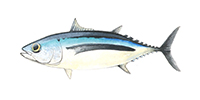Thank you for visiting the Seafood Selector. EDF is planning a new approach to providing information to consumers about good seafood choices. Please come back soon for updates.
Tuna

Albacore tuna, © Amadeo Bachar
Recommended servings per month
| Contaminant | Men | Women | Kids 6-12 | Kids 0-5 | |
|---|---|---|---|---|---|
| Albacore (U.S., Canada) | Mercury | 4+ | 4+ | 3 | 2 |
| Light tuna (Skipjack, canned) | Mercury | 4+ | 4+ | 4+ | 3 |
| Yellowfin (Western Central Pacific, handline) | Unknown | 4+ | 4+ | 3 | 2 |
| Albacore (imported, longline) | Mercury | 4 | 4 | 4 | 4 |
| Bigeye/yellowfin (imported troll/pole) | Unknown | 4 | 4 | 4 | 4 |
| Yellowfin (U.S. Atlantic troll/pole) | Unknown | 4 | 4 | 4 | 4 |
| White/albacore tuna (canned) | Mercury | 3 | 3 | 2 | 1 |
| Blackfin (U.S., Canada) | Mercury | 1 | 1 | < 1 | < 1 |
| Bluefin | Mercury, *PCBs | 1 | 1 | < 1 | < 1 |
Eco details:
- Albacore, bigeye, yellowfin and skipjack are resilient to fishing pressure because they grow quickly and reproduce often.
- Bluefin tuna, on the other hand, grow slower and take longer to reproduce. This, coupled with their exorbitant value in the sushi market, has led to severely depleted populations.
- Bigeye and yellowfin, also known as ahi, are common in sushi. Both types, along with bluefin, are high in mercury and should be eaten infrequently, if at all.
- Most tuna are caught by purse seines or longlines, which have moderate-to-high bycatch of seabirds, sea turtles and marine mammals.
- Pole-and-line caught tuna is less common but is a better environmental choice.




